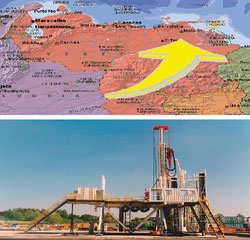 Technology from Europe: Technology from Europe:
Italy
Innovative hydraulic drilling rigs P. Alfieri, Soilmec S.p.A.
In the last 30 years, the oil industry has extended its operations in more difficult areas and environments. Starting in the 1970s with exploration in the North Sea, operators were confronted with hostile environments and high-cost daily operations. One factor that influenced these costs was accidents on the drilling rigs. These affected not only day-to-day operations, they also had a big social impact; and it became clear that something should be done. The big question was – how to combine performances with safety.
In earlier operations, almost all equipment handling involved manual work or presence of personnel on the drill floor. And pipe handling was one of the most common scenarios for accidents. Motivated by these issues, industry tried to combine safety and performance with systems like the first automatic slips, power tongs and Iron Roughnecks.
Since the beginning of the Hydraulic Hoist Project, Soilmec considered safety the starting point of the development of its New Concept drilling rig. The HH-series drilling rigs are based on innovative concepts to allow easy and fast mob/demob; i.e., for wells where drilling time is short, compared to moving time, this is the ideal application. The rig layout reduced the area dedicated to the rig site. This smaller area and the soundproofing made the rig more suitable for applications in environmentally sensitive and populated areas. Rig automation and reduced personnel created both a safer environment and better performance. And economic analyses demonstrate the good results obtained. The learning curve and use of complementary technology, e.g., unitized wellheads and CT completions, can further improve benefits.
The HH-series rigs have been built with the highest safety standards to improve efficiency. And they have been used in Venezuela by PDVSA, the state oil company, with positive results (see accompanying figure). Due to the innovative system, personnel working on the rig had to modify its approach to the new concept, especially concerning tubular handling. The new practice took a little time and, in early operations, some accidents occurred. After this initial training period, measures taken to improve safety achieved the primary aim and the learning curve shows that only minor accidents occurred in one year of operation.
 |
Example HH-200 rig on location for operator PDVSA in Venezuela.
|
|
A few of the long list of specific project objectives include improved operations and reduced accidents by:
- An automatic pipe handling system to handle tubulars without manual work
- Automatic make-up and break-out of BHAs with power tongs and slips by means of automatic power tongs and power slips
- Hydraulic top drive
- No personnel on the floor during drilling operations
- A hydraulic system for BOP handling
- A vertical pipe racking system.
For future improvements, a continuous optimization process is underway, both in terms of operational performance, personnel training and rig-site management (auxiliary equipment layout). Thanks to the good results/experience with the first versions of the hydraulic drilling rigs operating in Venezuela, drilling contractors have undertaken the construction of more powerful rigs, based on the same concepts and principles. The new rig, named HH-300, rated for 272 t static load capacity, is under construction at the Soilmec factory, in Piacenza. Offshore applications of the same principles featured by the HH-series rigs are suggested to reduce working space, operation risks and crew-member numbers. Range of applications run from workover rigs on fixed structures to installation offshore on semis or multi-purpose vessels for light workover or slimhole drilling in deepwater environments.
In summary, the HH-series rigs were designed to meet, and exceed, demanding technological and safety requirements that characterize drilling activity today, especially in terms of integration of services. Cooperation between company and contractor has made possible this innovative rig that has a competitive benefit for drilling medium and shallow depth wells, in terms of performance, safety and economic returns. Reduction in weight and dimensions, as well as enhanced automation to minimize crew, is the focus of the rig design. The Soilmec experience in onshore applications of hydraulic hoist rigs can be now successfully applied for offshore purposes.
This article was prepared from the OMC copyright 2003 paper “Automatic systems to drilling rigs to increase performances and reduce drastically the possibilities of accidents to the drilling crew members,” authored by P. Alfieri and S. Trevisani presented at the Offshore Mediterranean Conference and Exhibition, Ravenna, Italy, March 26 – 28, 2003. 
|

 Technology from Europe:
Technology from Europe:

